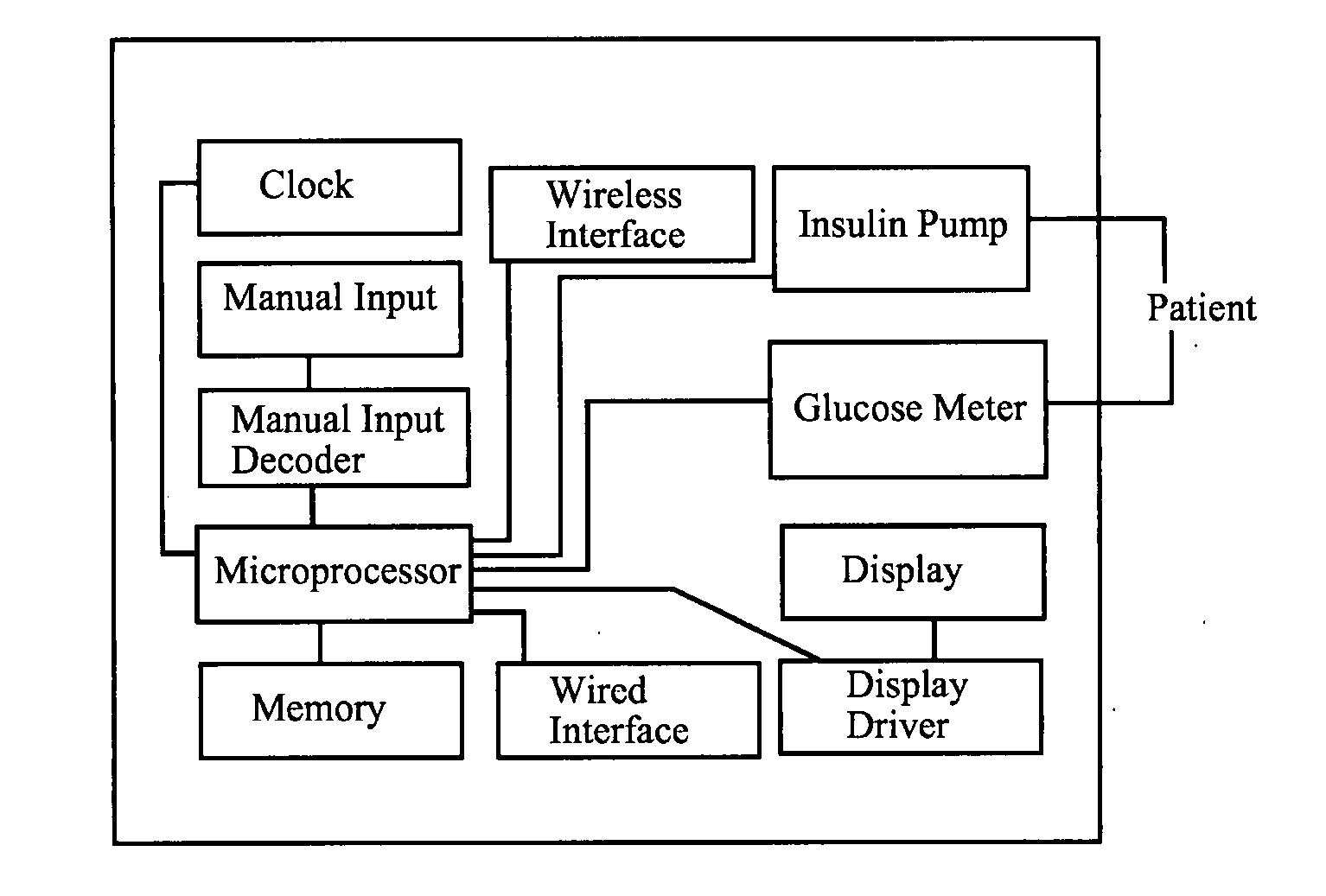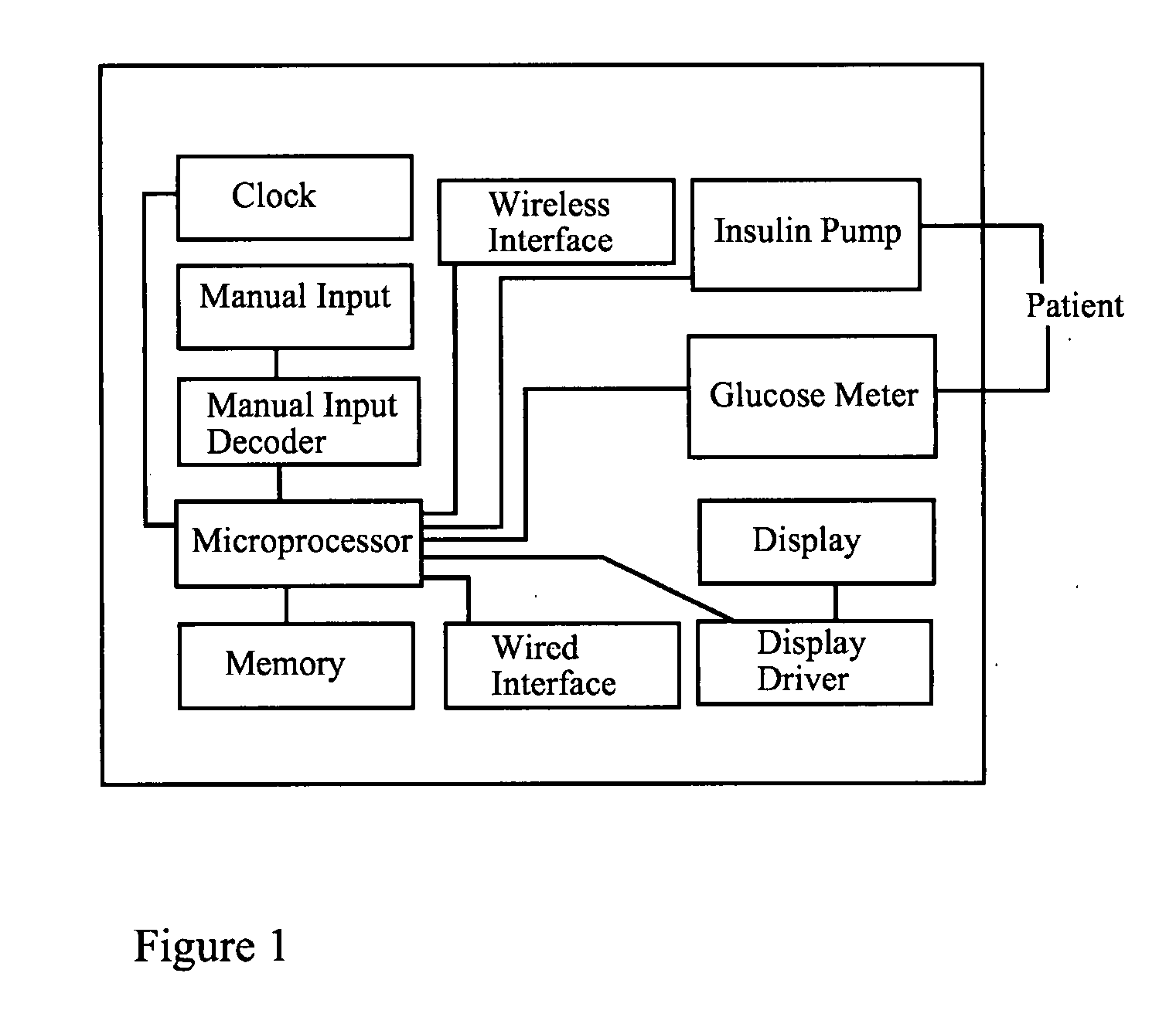[0035]Embodiments of the present invention comprise a
system for predicting and managing blood glucose concentration that calculates a recent past amount and / or rate of insulin usage in the pharmacodynamic sense, or specifically, a recent past∫t1t2[(PDIUE)t]tand / or d(PDIUE) / dt, or synonymously, a recent past amount and / or rate of PDIUE expenditure, in order to correlate it with recent past BGC data and communicate the relationship between them to a user. A
system can accept
user input defining how the user expects the relationship between the amount and / or rate of PDIUE expenditure on one hand and BGC on the other hand to evolve over the near future. Based on this
user input, a system can predict the evolution of near future BGC. In response to the system's prediction, the user can pursue a desired BGC result by optionally adjusting insulin delivery
programming, consuming
carbohydrate, and / or taking other action. A system of the invention may be integrated with an insulin
delivery system, such as an
insulin pump, and / or with a BGC monitoring device, such as a point-in-time glucometer or a continuous glucose monitor. Such integration may facilitate the transfer of insulin dosing information and BGC data to a system of the invention, the transfer otherwise being accomplished by manual input using art methods, a necessity for the capture of insulin dosing information related to
insulin injection by
syringe. Integration may also facilitate the adoption of insulin delivery recommendations, which a system of the invention may make, by facilitating transfer of such recommendations to an insulin
delivery system. Integration may also produce economies such as the need for fewer
graphical display screens.
[0038]An embodiment of the invention is a device for managing blood glucose concentration comprising a means for inputting at least two recent past blood glucose concentration data items, where each data item comprises a blood glucose concentration value and a time-of-measurement value. The device further comprises a means for inputting insulin delivery data items, where each data item comprises an
insulin dosage amount and a time-of-delivery value; a means for inputting insulin time-action profile data; a means for inputting patient RBGC / I data, the responsiveness of the patient's blood glucose concentration to insulin, optionally as a function of
time of day; and a means for inputting phamacodynamic insulin unit equivalent expenditure data. The PDIUE data are selected from the group consisting of d(PDIUE) / dt data, a rate of pharmacodynamic insulin unit equivalent expenditure; and∫t1t2[(PDIUE) / t]tdata, an amount of pharmacodynamic insulin unit equivalent expenditure between times t1 and t2, where t1 precedes t2. The device is further comprised of a
microprocessor connected to the input means, where the
microprocessor is also connected to a
digital memory, and to wired or
wireless communication means. The
microprocessor is configured to perform calculations based upon inputted recent past blood glucose concentration data, inputted insulin delivery data, inputted insulin time-action profile data, inputted patient RBGC / I data, and at least one of: inputted d(PDIUE) / dt data, and inputted∫t1t2[(PDIUE) / t]tdata. The microprocessor is configured to calculate d(PDIUE) / dt and / or∫t1at2a[(PDIUE) / t]t.The times t1a and t2a may be independently the same as, or different from, t1 and t2. The microprocessor is optionally configured to calculate∫tct∞[(PDIUE) / t]t,IOB. There is a display connected to the microprocessor for displaying the calculation results including at least one of d(PDIUE) / dt and∫t1at2a[(PDIUE) / t]t.In addition,∫tct∞[(PDIUE) / t]tmay optionally be displayed. Optionally, the device may use values for t1 and t1a that are no more than five hours in the past, and values for t2 and t2a that are no more than seven hours in the future, and where d(PDIUE) / dt corresponds to a time no more than five hours in the past and no more than seven hours in the future. Optionally, the device may calculate and display d(PDIUE) / dt and [d(PDIUE) / dt] dt that are BGC-neutral. Optionally, the device may use inputted d(PDIUE) / dt and [d(PDIUE) / dt] dt that are BGC-neutral. Optionally, the device may use either a keyboard or a touch screen as a means for inputting data. The keyboard and / or touch screen facilitate the manual input of data, and in addition the touch screen may optionally function as a display. The device may optionally comprise a
glucose meter connected to the microprocessor, and the device may optionally comprise an insulin pump connected to the microprocessor. The optional
glucose meter and insulin pump may be fully integrated with a device of the invention, or they may be separate devices which are in communication with a device of the invention. The communication between a device of the invention and a
glucose meter and / or insulin pump may occur via either wired or
wireless communication means.
[0039]An embodiment of the invention is a device for managing blood glucose concentration comprising a means for inputting insulin delivery data items, where each data item comprises an
insulin dosage amount and a time-of-delivery value; a means for inputting insulin time-action profile data, and a means for inputting phamacodynamic insulin unit equivalent expenditure data. The PDIUE data are selected from the group consisting of d(PDIUE) / dt data, a rate of pharmacodynamic insulin unit equivalent expenditure; and∫t1t2[(PDIUE) / t]tdata, an amount of pharmacodynamic insulin unit equivalent expenditure between times t1 and t2, where t1 precedes t2. The device is further comprised of a microprocessor connected to the input means, where the microprocessor is also connected to a
digital memory, and to wired or
wireless communication means. The microprocessor is configured to perform calculations based upon inputted insulin delivery data, inputted insulin time-action profile data, and at least one of: inputted d(PDIUE) / dt data, and inputted∫t1t2[(PDIUE) / t]tdata. The microprocessor is configured to calculate d(PDIUE) / dt and / or∫t1at2a[(PDIUE) / t]t.The times t1a and t2a may be independently the same as, or different from, t1 and t2. The microprocessor is optionally configured to calculate∫tct∞[(PDIUE) / t]t,IOB. There is a display connected to the microprocessor for displaying the calculation results including at least one of d(PDIUE) / dt and∫t1at2a[(PDIUE) / t]t.In addition,∫tct∞[(PDIUE) / t]tmay optionally be displayed. Optionally, the device may use values for t1 and t1a that are no more than five hours in the past, and values for t2 and t2a that are no more than seven hours in the future, and where d(PDIUE) / dt corresponds to a time no more than five hours in the past and no more than seven hours in the future. Optionally, the device may use either a keyboard or a touch screen as a means for inputting data. The keyboard and / or touch screen facilitate the manual input of data, and in addition the touch screen may optionally function as a display. The device may optionally comprise an insulin pump connected to the microprocessor. The optional insulin pump may be fully integrated with a device of the invention, or it may be a separate device which is in communication with a device of the invention. The communication between a device of the invention and an insulin pump may occur via either wired or wireless communication means.
[0040]An embodiment of the invention is a device for managing blood glucose concentration comprising a means for inputting insulin delivery data items, where each data item comprises an
insulin dosage amount and a time-of-delivery value; and a means for inputting insulin time-action profile data. The device is further comprised of a microprocessor connected to the input means, where the microprocessor is also connected to a
digital memory, and to wired or wireless communication means. The microprocessor is configured to perform calculations based upon inputted insulin delivery data and inputted insulin time-action profile data. The microprocessor is configured to calculate d(PDIUE) / dt and / or∫t1at2a[(PDIUE) / t]tbetween times t1a and t2a where t1a precedes t2a. The microprocessor is optionally configured to calculate∫tct∞[(PDIUE)t]t,IOB. There is a display connected to the microprocessor for displaying the calculation results including at least one of d(PDIUE) / dt and∫t1at2a[(PDIUE)t]t.In addition,∫tct∞[(PDIUE)t]tmay optionally be displayed. Optionally, the device may use either a keyboard or a touch screen as a means for inputting data. The keyboard and / or touch screen facilitate the manual input of data, and in addition the touch screen may optionally function as a display. The device may optionally comprise an insulin pump connected to the microprocessor. The optional insulin pump may be fully integrated with a device of the invention, or it may be a separate device which is in communication with a device of the invention. The communication between a device of the invention and an insulin pump may occur via either wired or wireless communication means.
 Login to View More
Login to View More  Login to View More
Login to View More 


